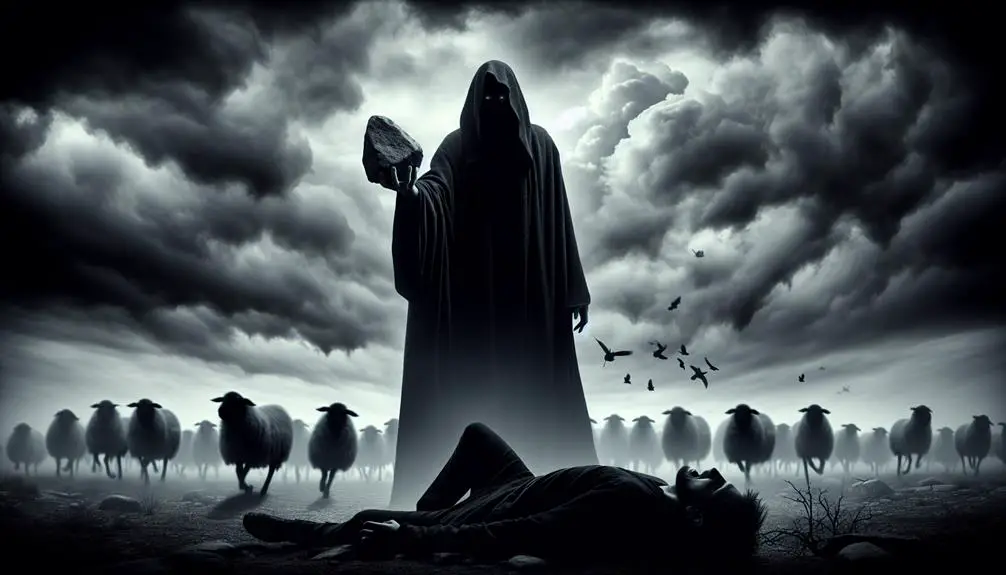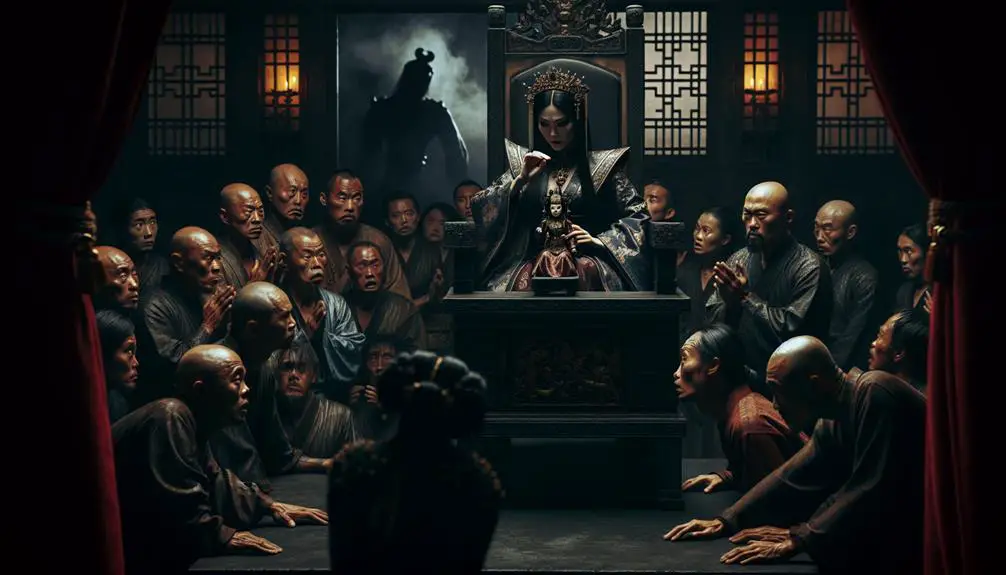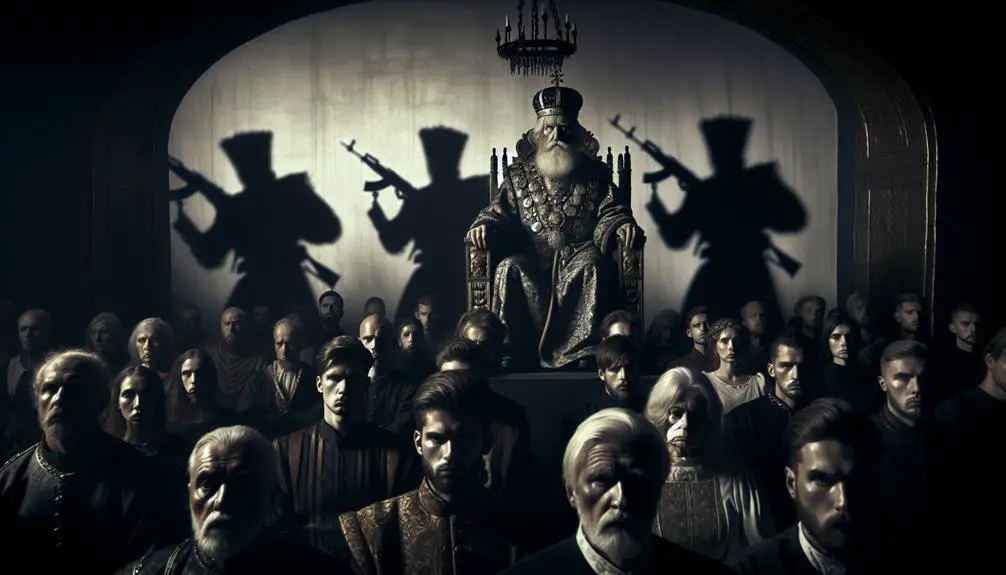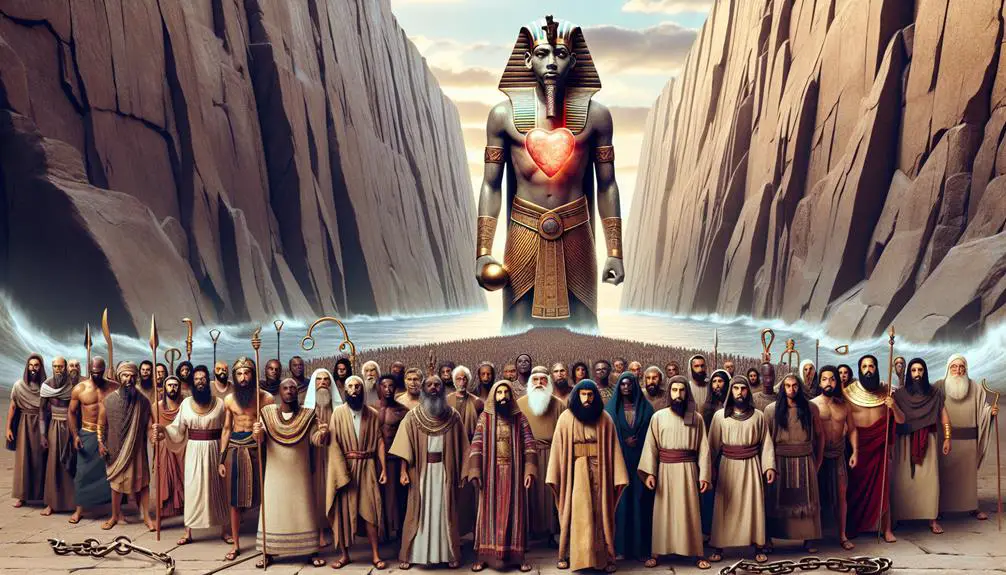Yielding lessons from history, explore how the Bible's most notorious characters offer insights into our own moral complexities.

Bad Characters in the Bible
Just as you're pondering the complexity of human nature, it's interesting to note how the Bible doesn't shy away from portraying its fair share of notorious characters. From the cunning serpent in Eden to the treacherous betrayal by Judas Iscariot, these figures are pivotal in understanding the broader themes of temptation, sin, and redemption that weave through the scriptures.
You'll find their stories not only compelling but also surprisingly relevant to today's moral dilemmas. Let's navigate these ancient narratives together, and see what lessons they may hold for us in the modern world.
Key Takeaways
- Biblical narratives use characters like the Serpent and Jezebel to symbolize the dangers of evil and tyranny.
- Stories of Cain and King Herod exemplify the destructive consequences of jealousy and unchecked power.
- Figures such as Judas Iscariot and Pharaoh highlight the complex interplay between divine will and human responsibility.
- These characters serve as cautionary tales, teaching lessons on moral responsibility, the importance of heeding divine warnings, and the potential for redemption.
The Serpent in Eden

In the narrative of Eden, the Serpent emerges as a pivotal figure of temptation, challenging the moral integrity of humanity through its cunning interaction with Eve. This encounter between Eve and the Serpent isn't just a tale of deceit; it's a complex narrative rich with symbolic interpretation and moral lessons that resonate through time. You're invited to delve deeper into this narrative to uncover the layers of meaning that have been interpreted in various ways by theologians and scholars alike.
The Serpent, often seen as embodying evil or sin, plays a critical role in the story of humanity's fall from grace. Its ability to speak and reason, to persuade Eve to partake of the forbidden fruit, marks it as a creature of significant intelligence and malevolence. This act of temptation leads to the expulsion of Adam and Eve from Eden, an event that has been interpreted as the moment sin entered the world.
Symbolic interpretation of the Serpent extends beyond its role as a mere tempter. It represents the complexities of moral decision-making, the allure of forbidden knowledge, and the consequences of disobedience. The story underscores the importance of vigilance and integrity in the face of temptation, offering a moral lesson that remains relevant.
Cain: The First Murderer

You'll find Cain's story to be a seminal moment in biblical narrative, highlighting the devastating impact of jealousy.
Cain's jealousy towards his brother Abel leads him to commit the first murder, a decision that brings profound consequences.
This act not only marks him as the first murderer but also sets a precedent for human behavior and divine judgment in the texts that follow.
Cain's Jealous Rage
Cain's descent into murderous rage, sparked by jealousy over his brother Abel's favored status, marks a profound moment of moral failure in biblical history. This incident, rooted in sibling rivalry, unfolds as both brothers present their agricultural offerings to God. Cain, the tiller of the ground, offers crops, while Abel, the keeper of sheep, offers the fat portions of the firstborn of his flock. God's preference for Abel's offering ignites Cain's jealousy, setting the stage for the tragic outcome.
Aspect |
Details |
|---|---|
Keywords |
Sibling rivalry, Agricultural offerings |
Primary Cause |
Jealousy over favored offerings |
Outcome |
Cain's murderous rage |
This analysis reveals how unchecked emotions can lead to catastrophic moral failures, emphasizing the importance of addressing jealousy and rivalry constructively.
Consequences of Cain's Actions
Following the brutal murder of Abel, the consequences of Cain's actions ripple through biblical history as a stark warning against the perils of unchecked jealousy and violence. The repercussions of Cain's deed extend beyond immediate divine punishment; they cast a long shadow over Cain's lineage. His descendants, marked by this original act of fratricide, navigate a world where their progenitor's legacy influences their identities and societal roles.
Moreover, Cain's banishment affects agricultural practices, symbolizing a disrupted harmony with the earth. This shift not only signifies a moral and spiritual estrangement but also a practical challenge in sustaining livelihoods. Cain's story, thus, serves as a multifaceted lesson on the profound impact of individual actions on community, ethics, and the environment, echoing through generations.
Jezebel's Idolatry and Tyranny

You'll find that Jezebel's introduction of pagan worship practices into Israel not only contravened the religious norms of the time but also catalyzed a broader cultural and spiritual shift.
Her tyrannical rule over Israel, marked by an iron fist and a disregard for traditional values, set a precedent for governance that prioritized personal belief over communal welfare.
Moreover, her persecution and murder of prophets who opposed her idolatrous ways underscored the lengths to which she'd go to silence dissent and maintain her power.
Jezebel's Pagan Worship Practices
Jezebel's fervent promotion of pagan worship significantly challenged the monotheistic foundations of ancient Israelite society. Leveraging Ahab's influence and the Tyrian alliances, she introduced and ardently supported the worship of Baal and Asherah, deities from her native Phoenician culture.
This strategic move wasn't merely a personal or religious preference but a political maneuver to solidify power and extend Tyrian influence within Israel. By integrating her homeland's gods into the fabric of Israelite worship, Jezebel directly confronted the Yahwistic practices that had defined the nation. Her actions catalyzed a spiritual crisis, undermining the prophets of Yahweh and eroding the religious homogeneity that had united the Israelite tribes under a common faith and identity.
Tyrannical Rule Over Israel
Building on her promotion of pagan worship, Jezebel's rule over Israel further escalated into a period marked by tyranny and the suppression of any dissent against her religious reforms. You'll find her actions reminiscent of earlier dark periods in Israel's history, such as Solomon's downfall and Absalom's rebellion, both of which fractured the unity and faith of the nation.
Jezebel's imposition of idolatry, coupled with her ruthless tactics to maintain power, exemplifies a tyrannical governance that not only alienated her subjects but also further destabilized the spiritual and political landscape of Israel. Her regime's oppressive nature, marked by an iron-fisted control over religious practices, mirrors the internal conflicts and moral decay that precipitated the nation's struggles during Solomon's rule and Absalom's insurrection.
Prophets' Persecution and Murder
Amid her fervent promotion of idolatry, Jezebel not only suppressed dissent but also pursued a ruthless campaign against the prophets of Israel, leading to widespread persecution and murder. Elevating false prophets, she solidified her grip on power, intertwining political authority with the worship of Baal and Asherah.
This strategy not only marginalized the true prophets but actively sought their elimination. Public stoning became a terrifying tool in her arsenal, a method used to instill fear among those who dared oppose her religious reforms.
Jezebel's actions depict a grim tableau of tyranny, where spiritual corruption facilitated the silencing and murdering of voices of truth, highlighting a dark period in Israel's history characterized by the suppression of divine guidance in favor of idolatrous practices.
Judas Iscariot's Betrayal

One of the most pivotal moments in biblical history is Judas Iscariot's betrayal of Jesus Christ, an act that has been analyzed and interpreted through various theological lenses. This event not only led to the crucifixion of Jesus but also left an indelible mark on the narrative of Christian theology, raising questions about loyalty, free will, and divine providence.
Judas' actions are often seen through the lens of his subsequent remorse and the Apostolic replacement that followed his demise. His betrayal, for thirty pieces of silver, is a complex tableau of human frailty, divine orchestration, and the inexorable march towards a foretold destiny.
Consider these aspects:
- Judas' Remorse: After betraying Jesus, Judas was overwhelmed with guilt. This remorse led him to return the silver and ultimately to his suicide, a tragic end that underscores the depth of his regret.
- Apostolic Replacement: Following Judas' death, Matthias was chosen to replace him as one of the twelve apostles. This act of replacement symbolizes renewal and the unbroken continuity of the Apostolic mission, despite individual failings.
- Theological Implications: Judas' betrayal and its aftermath have sparked endless debate regarding predestination and free will. His actions serve as a fulcrum, challenging believers to consider the complexities of divine plan versus human agency.
Analyzing Judas Iscariot's betrayal requires grappling with themes of betrayal, redemption, and the inscrutable will of the divine. It's a narrative that compels one to reflect on the nature of forgiveness, the possibility of repentance, and the profound mystery of divine justice.
King Herod's Ruthlessness

ARTICLE TITLE: Bad Characters in the Bible
PREVIOUS SUBTOPIC: 'Judas Iscariot's Betrayal'
CURRENT SUBTOPIC: 'King Herod's Ruthlessness'
King Herod's ruthlessness, particularly evident in his order to massacre the innocents of Bethlehem, starkly illustrates the lengths to which he would go to protect his reign from perceived threats. His reign, marked by fear and brutality, also saw grandiose construction projects and heavy taxation policies that further cemented his legacy as a tyrant in the annals of history.
Herod's architecture, a testament to his desire to leave a lasting legacy, includes the magnificent expansion of the Second Temple in Jerusalem and the construction of the fortress at Masada. These projects, while remarkable, were funded by oppressive taxation policies that burdened the populace, exacerbating the suffering under his rule.
Aspect |
Description |
Impact on People |
|---|---|---|
Massacre of the Innocents |
Herod's order to kill all male infants in Bethlehem |
Fear and mourning in Judea |
Herod's Architecture |
Grand projects like the expansion of the Second Temple |
Showcased power but burdened people with taxes |
Taxation Policies |
Heavy taxes to fund construction and secure loyalty |
Increased suffering and discontent among the populace |
Analyzing Herod's reign, it's clear that his actions were driven by a deep-seated paranoia and a relentless desire to maintain power. The architectural marvels he left behind stand in stark contrast to the tyranny and suffering endured by his subjects. Herod's story serves as a powerful reminder of the destructive potential of unchecked power and ambition.
Pharaoh's Hardened Heart

Shifting focus from King Herod's tyrannical reign, we now examine the story of Pharaoh in the Exodus, whose hardened heart symbolizes the perils of stubbornness and refusal to heed warnings. This narrative intricately weaves together themes of divine sovereignty and human responsibility, presenting a complex interplay that has intrigued scholars and believers alike.
The account of Pharaoh's hardened heart raises critical questions about the balance between divine intervention and human free will. Here's a visual breakdown:
- Divine Sovereignty: The Bible repeatedly mentions that God hardened Pharaoh's heart. This assertion highlights a divine purpose behind the events, suggesting that the unfolding of the plagues and the eventual liberation of the Israelites were part of a larger, divine plan. It underscores the notion that, in certain instances, divine sovereignty can direct human actions for a greater purpose.
- Human Responsibility: Despite the emphasis on divine intervention, the story doesn't absolve Pharaoh of his role. His initial refusal to let the Israelites go, driven by pride and tyranny, sets the stage for the subsequent hardening of his heart. This aspect of the story serves as a cautionary tale about the consequences of stubbornness and the importance of heeding warnings.
- Interplay Between Divine and Human Actions: The narrative invites readers to ponder the relationship between God's will and human agency. It suggests that while divine sovereignty is overarching, individuals still bear responsibility for their choices and the paths they choose.
In analyzing Pharaoh's hardened heart, you're invited to reflect on the complexities of divine sovereignty and human responsibility, offering insights into the enduring relevance of these themes in understanding human behavior and divine interaction.
Frequently Asked Questions
How Have Interpretations of These "Bad Characters" Evolved in Different Cultures and Religious Traditions Over Time?
You've noticed how interpretations of certain figures have shifted across cultures and religious traditions. Artistic representations play a key role, depicting these characters in varied lights, influencing public perception.
Cultural festivals, too, have transformed their narratives, sometimes celebrating their complexities rather than condemning them outright. This evolution reflects broader changes in societal values and understanding, as communities reexamine traditional views, fostering a more nuanced approach to historical and religious interpretation.
Can the Actions of These Figures Be Understood Differently When Considering the Historical and Societal Context of the Periods in Which the Stories Were Written?
Imagine you're analyzing a historical figure's controversial actions. It's crucial to consider the period's societal norms and historical context. This approach isn't just about seeking excuses but understanding motivations and pressures.
When evaluating stories, historical accuracy, and literary symbolism offer deep insights. By peeling back the layers of time, you gain a nuanced perspective, recognizing that actions, often judged harshly, are multifaceted when viewed through the lens of their era.
Are There Any Psychological Theories That Explain the Motivations or Behaviors of These Individuals Beyond What Is Described in the Biblical Narratives?
You're exploring whether psychological theories, like personality disorders and evolutionary psychology, offer insights into motivations or behaviors beyond traditional narratives.
Personality disorders could provide a framework for understanding complex behaviors, while evolutionary psychology might explain these actions as survival strategies.
This analytical approach allows for an objective examination of characters' motivations, potentially offering a deeper understanding of their actions without relying solely on historical or textual analysis.
How Do Modern Interpretations of These Characters Vary Between Different Branches of Christianity and Judaism?
Imagine a painting where each stroke and color variation tells a different story. In the same way, modern interpretations of biblical characters differ across Christian and Jewish traditions.
Artistic representations and educational curriculum serve as the canvas and brushes that paint these varied portraits. While some branches emphasize redemption and moral lessons, others might focus on the historical and cultural context, leading to a rich tapestry of understanding that's both analytical and objective.
What Role Do These Characters Play in Contemporary Discussions on Morality, Ethics, and Human Nature?
In contemporary discussions on morality, ethics, and human nature, you'll find that media representation plays a crucial role. It often reflects and shapes public perceptions of ethical relativism, showing how views on right and wrong can vary widely.
These debates highlight the complexity of human nature and challenge you to consider the fluidity of moral standards. Through this lens, you're encouraged to analyze and question the very foundation of your ethical beliefs.
Conclusion
In analyzing these figures, you've journeyed through a gallery of shadows, each character a brushstroke on the canvas of biblical narratives. Their actions, from the Serpent's deceit to Herod's brutality, highlight the complex interplay of morality, power, and faith.
Like stars in a night sky, their stories illuminate the darker aspects of human nature, urging you to reflect on the choices that define us. Understanding their roles offers valuable insights into the timeless struggle between good and evil.



Sign up